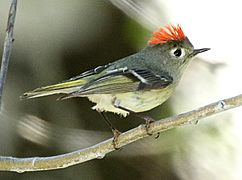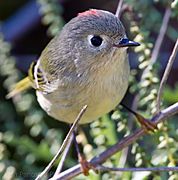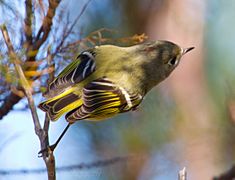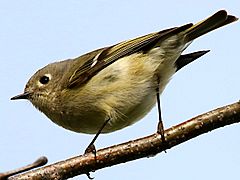Ruby-crowned kinglet facts for kids
Quick facts for kids Ruby-crowned kinglet |
|
|---|---|
 |
|
| Male in Anchorage, Alaska | |
| Conservation status | |
| Scientific classification | |
 |
|
| Range of R. calendula
Year round Summer (breeding) Winter (nonbreeding) (ranges are approximate) |
|
| Synonyms | |
|
Regulus calendula Linnaeus, 1766 |
The ruby-crowned kinglet (Regulus calendula) is a tiny passerine bird. You can find it all over North America. It belongs to the kinglet family. This bird has olive-green feathers. It also has two white bars on its wings and a white ring around its eye. Male kinglets have a bright red patch on their head. This patch is usually hidden by other feathers.
Both male and female kinglets look alike, except for the male's hidden red patch. Young birds look similar to adults. The ruby-crowned kinglet is one of the smallest songbirds in North America. It travels long distances, flying from northwest Canada and Alaska down to Mexico. Some stay in the west all year.
Contents
What Does a Ruby-crowned Kinglet Look Like?
The ruby-crowned kinglet is a very small bird. It is about 9 to 11 centimeters (3.5 to 4.3 inches) long. Its wings can spread 16 to 18 centimeters (6.3 to 7.1 inches) wide. It weighs only 5 to 10 grams (0.18 to 0.35 ounces). Its upper body is gray-green. Its belly is olive-buff. It has two white bars on its wings and a broken white ring around its eye. The wing bar closer to the tip is wider. It sits next to a dark band.
The male bird has a bright red patch on top of its head. This patch is usually covered by other feathers. Sometimes, the patch can be orange or yellow, or even missing. Females look just like males, but they do not have the red crown patch. Young male birds also do not have the red patch.
This kinglet moves by hopping along branches. It also flies with quick bursts of wing beats. It is always active. You can often spot it by its special wing-flicking movement. Its flight is fast and a bit jerky.
The ruby-crowned kinglet is a bit larger than the golden-crowned kinglet. It is also greener. Its red crown is different from the orange or yellow crowns of other kinglets. People sometimes confuse it with the Hutton's vireo. That bird also flicks its wings, but not as often. The dwarf vireo in Mexico can also look similar. However, both vireos are bigger. They have thicker beaks and legs. They also do not have the kinglet's black bar on its wings.
Kinglet Calls and Songs
The ruby-crowned kinglet makes very loud and complex sounds for its size. Its song has three main parts. First, there are high-pitched notes like zee-zee-zee. Then, there are two to five low trills, like turr. Finally, there is a repeated three-note sound, like tee-da-leet.
However, individual birds might sing different versions. Their songs often have only one or two of these parts. Only male birds sing the third part. Females sing a shorter version. Kinglets also make alarm calls. They have simple calls to stay in touch. Baby birds make begging calls.
Where Do Kinglets Live?
Ruby-crowned kinglets breed in coniferous forests. These forests are found across Canada, Alaska, northern New England, and the western United States. They build their nests in a hidden spot. The nest is a cup shape. It hangs from a conifer branch. A female kinglet can lay up to twelve eggs at once. This is a very large number for a North American songbird of its size!
The number of ruby-crowned kinglets is growing. This is because people have found new, quiet areas farther north. These areas help the birds breed more successfully. After breeding, these birds migrate to the southern United States and Mexico. Some kinglets stay in the western parts of the United States all year.
How Do Kinglets Behave?
Ruby-crowned kinglets are very active. They look for food in trees and bushes. They mostly eat small insects and spiders. They also eat some berries and tree sap. They might hover over a branch to eat. Sometimes, they fly out to catch insects in the air.
When a male kinglet is upset or showing off, it raises its red head patch. Kinglets sometimes pretend to have a "broken wing." This trick helps them lead predators away from their nest. They will bravely defend their nest. They might even mob, or attack, an intruder. This intruder could be a cat, a squirrel, or even a human!
See also
 In Spanish: Reyezuelo rubí para niños
In Spanish: Reyezuelo rubí para niños







